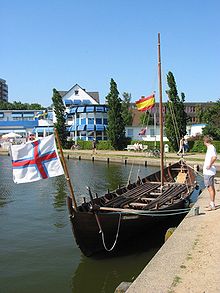Faroe boat

The Faroe Islands ( Faroese : føroyskur bátur ) is a special type of boat that is unique to the Faroe Islands . For the Faroese it is a handcrafted cultural asset of the first order.
The Faroe boat comes from the Viking ship . Originally from Norway , it was later built from driftwood and imported boards. Various factors were decisive for the slim and light construction of the seaworthy boats:
- Strong currents in the Faroese Sound and rough seas in the open North Atlantic
- Strong down winds in the sounds and fjords through the high mountains.
- Chronic lack of wood in the treeless Faroe Islands.
Over the centuries, the Faroe boat was the only type of boat that was built on the Faroe Islands. It was not until 1804 that Nólsoyar Páll built the first ocean-going sailing ship with Royndin Fríða . One reason for this long restriction on vehicles that are not actually intended for an Atlantic crossing was the monopoly trade over the Faroe Islands , which meant that there were no ships other than those of the trading company.
Nevertheless, the Faroe Islands were used for trips to the Shetland Islands , Orkney and Scotland to procure food in times of monopoly trade. With this, these boats proved their seaworthiness over longer distances. In 1986 Ove Joensen proved that you can row to Copenhagen alone in a Faroe boat. His Diana Victoria is on display in his hometown of Nólsoy . The Naddoddur was launched in 1997, it is the largest classic Faroe boat without a motor for about 100 years - a proud 12 with a crew of 14. With this the crew rowed and sailed to Iceland and Norway .
The Faroe boat is traditionally a rowing boat , which could also be fitted with a lug sail , which, however, repeatedly capsized. So people were generally very grateful when the first engines appeared, which are now either installed as an outboard or - more often - as a machine. In addition, many of these motorboats have a small structure that provides a certain degree of weather protection. These boats are primarily used for inshore fishing and grindadráp .
The rowing boat was further developed into a regatta boat, see Faroese rowing .
You can see old Faroe boats in the History Museum of the Faroe Islands or in the Boat Museum in Leirvík . In Christianskirkja in Klaksvík , a historic Faroe boat hangs in the nave.
Boat classes
The Faroe boats are traditionally named after the number of rowers, or the number of benches (Tríbekkur = 3 benches) or the oars on one side (Seksæringur = 6x2 oars). The length is measured in feet , where the Faroese foot ( fótur , plural føtur ) corresponds to the Prussian foot , i.e. 31.385 cm.
| Surname | length | Rowers | Special |
|---|---|---|---|
| Tríbekkur | ~ 18 ft. | 2 | Smallest type of Faroe boat |
| Sadness | 18 ft. | 3 | Slightly larger than a Tríbekkur |
| Fýramannafar | 20 ft. | 4th | Two rowers sit on the middle bench |
| Fimmmannafar | 21 ft. | 6th | Smallest regatta class for juniors and women |
| Seksmannafar | 22 ft. | 6th | Smallest regatta class for men, largest for women |
| Áttamannafar | 24-24.5 ft. | 8th | Is considered the "finest" Faroe boat |
| Tíggjumannafar | 26-27 ft. | 10 | "Premier class" at the end of every regatta |
| Seksæringur | 28-30 ft. | 12 | No competition class. This type is built today as a motorboat |
| Teinæringur | 40 ft. | 18th | Historic boat type for Atlantic crossings |
literature
- FLB.fo - Hin føroyski báturin ein bókalisti (complete bibliography of the National Library of the Faroe Islands on the subject)
- Andras Mortensen: Hin føroyski róðrarbáturin. Sjómentir føroyinga í eldri tíð. Annales Societatis Scientiarum Færoensis, Supplementum XXVI. Tórshavn, 2000. ISBN 99918-41-26-1 ( summary in English ... )
- Max Vinner: Viking Ship Museum Boats Max Vinner and Viking Ship Museum in Roskilde 2002, ISBN 87-85180-48-3 (English; with a detailed chapter on the Faroese boats in Roskilde and their typological classification)
- Morten Gøthche: Færøbåden , Vikingeskibshallen I Roskilde, 1985 (Danish; comprehensive historical overview and detailed documentation of the construction of an Ottemandsfare 1984 in Roskilde)
- Bent og Erik Andersen: Råsejlet - Dragens Vinge , Vikingeskibshallen, Roskilde, 1989, ISBN 87-85180-14-9 (Danish; the standard book on the historical development of ships of the Viking family, especially their sails)
Web links
- Naddoddur.com - Brief introduction (English)
- Neystid.dk - Neystið rowing club in Denmark (Danish)
- Drekin.fo - Tórshavner Rowing Club (Faroese)
- KRF.fo - Klaksvíker Rowing Club (Faroese)
